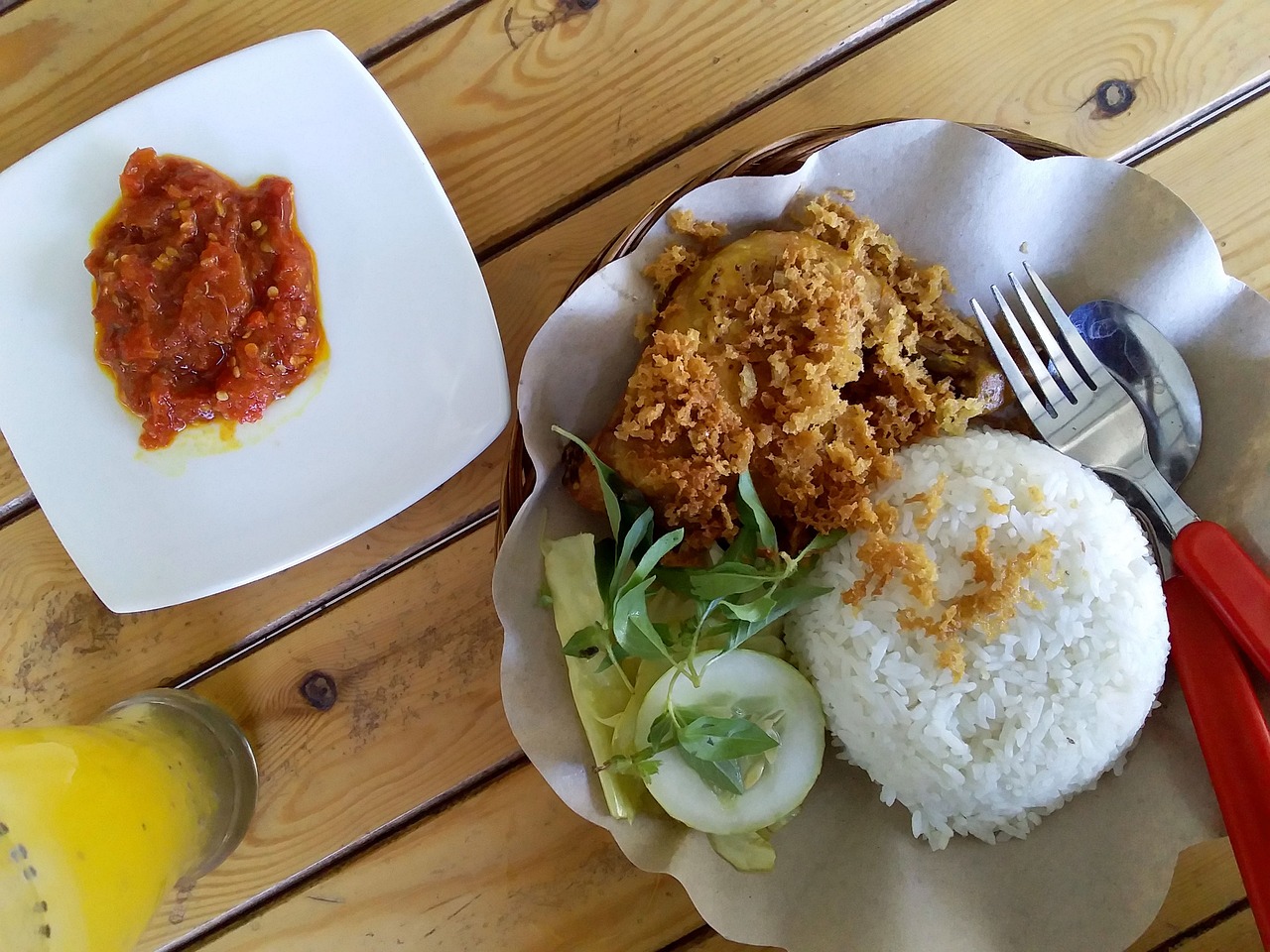Indonesian Nasi Goreng: Flavorful Fried Rice

Indonesian Nasi Goreng, a delightful and aromatic fried rice dish, holds a special place in the hearts of many food enthusiasts. The rich blend of flavors and textures in Nasi Goreng makes it a standout dish in Indonesian cuisine, renowned for its savory taste and cultural significance.
When you take a bite of Nasi Goreng, you embark on a culinary journey through the vibrant streets of Indonesia, where the aroma of spices fills the air and the sizzle of the wok creates a symphony of flavors. This dish is a true explosion of taste, combining sweet, salty, and umami notes in every mouthful.
The secret behind the irresistible taste of Nasi Goreng lies in its key ingredients. From fragrant rice and sweet kecap manis to pungent shrimp paste and aromatic shallots, each component plays a crucial role in creating the harmonious flavor profile that defines this beloved dish.
Preparing Nasi Goreng is an art form in itself, requiring skill and precision to achieve the perfect balance of flavors and textures. The rice is cooked to perfection, then stir-fried with a medley of spices, meats, and vegetables, creating a dish that is both comforting and exciting to the palate.
As you explore the regional variations of Nasi Goreng across Indonesia, you will encounter a myriad of unique interpretations that reflect the diverse culinary landscape of the country. Each region puts its own spin on this classic dish, showcasing the creativity and ingenuity of Indonesian chefs.
History of Nasi Goreng
The history of Nasi Goreng is a fascinating journey that delves into the heart of Indonesian culinary traditions. This beloved dish has deep roots in the rich tapestry of Indonesian cuisine, reflecting a blend of cultural influences and historical developments that have shaped its evolution over time.
Originating from humble beginnings, Nasi Goreng has its roots in traditional Indonesian cooking practices that date back centuries. It was born out of a need to repurpose leftover rice into a flavorful and satisfying meal, showcasing the resourcefulness and creativity of Indonesian cooks.
As Indonesian cuisine evolved and diversified, Nasi Goreng emerged as a staple dish enjoyed by people from all walks of life. Its popularity grew steadily, eventually becoming a symbol of Indonesian culinary identity and a source of national pride.
Throughout history, Nasi Goreng has undergone various adaptations and innovations, reflecting the dynamic nature of Indonesian gastronomy. Different regions and communities have put their unique spin on the dish, incorporating local ingredients and cooking techniques to create distinct regional variations.
Today, Nasi Goreng stands as a testament to the enduring legacy of Indonesian culinary heritage, showcasing the vibrant flavors and cultural significance that define this beloved fried rice dish. Its journey from a simple meal to a culinary icon is a testament to the power of food to unite people and preserve tradition.
Key Ingredients in Nasi Goreng
Nasi Goreng, the beloved Indonesian dish, is renowned for its unique and delicious flavor profile, achieved through a harmonious blend of key ingredients. These essential components come together to create a symphony of taste that delights the palate and embodies the rich culinary heritage of Indonesia.
At the heart of Nasi Goreng lies the humble yet versatile rice, a staple ingredient that serves as the foundation of this iconic dish. The rice used in Nasi Goreng is typically cooked and cooled beforehand, allowing it to achieve the perfect texture and consistency when stir-fried with the other components.
Kecap manis, a sweet and thick soy sauce, plays a pivotal role in enhancing the flavor profile of Nasi Goreng. This dark and syrupy sauce adds a touch of sweetness and depth to the dish, balancing out the savory and spicy elements for a well-rounded taste experience.
Shrimp paste, known for its intense umami flavor, is another key ingredient in Nasi Goreng. This pungent condiment adds a rich and complex dimension to the dish, infusing it with a depth of flavor that sets it apart from other fried rice variations.
Shallots and garlic, essential aromatics in Indonesian cuisine, bring their unique flavors to Nasi Goreng, creating a fragrant and aromatic base for the dish. These ingredients are typically finely chopped and sautéed to release their full flavor potential before being combined with the other components.
A variety of spices, such as turmeric, coriander, and cumin, are often used to season Nasi Goreng, adding layers of complexity and warmth to the dish. These aromatic spices contribute depth and nuance to the flavor profile, elevating Nasi Goreng to a culinary masterpiece.
In summary, the key ingredients in Nasi Goreng work in harmony to create a symphony of flavors that captivate the senses and showcase the culinary prowess of Indonesian cuisine. From the fragrant aromatics to the bold spices, each component plays a vital role in shaping the character of this iconic dish, making it a true culinary delight for food enthusiasts around the world.
Preparation Techniques
When it comes to preparing the flavorful Indonesian dish Nasi Goreng, there are several key techniques that contribute to its delicious taste and unique texture. Let's dive into the traditional methods and modern adaptations that make Nasi Goreng a beloved culinary masterpiece.
First and foremost, the quality of the rice used in Nasi Goreng plays a crucial role in its overall taste. Long-grain white rice is typically preferred for this dish as it cooks up fluffy and absorbs the flavors of the seasonings well. The rice is often cooked in advance and left to cool before being used in the stir-frying process.
One of the essential steps in preparing Nasi Goreng is creating the flavorful base for the dish. This is achieved by sautéing a mixture of shallots, garlic, and other aromatic spices in hot oil until fragrant. The addition of shrimp paste, known as "terasi" in Indonesian cuisine, brings a unique umami depth to the dish.
Once the base is aromatic and well-developed, the cooled rice is added to the pan and stir-fried with the seasonings. The key here is to continuously toss the rice to ensure that each grain is coated with the flavorful mixture evenly. This process helps to infuse every bite of Nasi Goreng with a harmonious blend of flavors.
Aside from the essential ingredients and seasonings, Nasi Goreng can be customized with a variety of toppings and accompaniments to suit individual preferences. Common additions include fried eggs, crispy shallots, sliced cucumbers, and prawn crackers, adding layers of texture and flavor to the dish.
For a modern twist on traditional Nasi Goreng preparation, some chefs experiment with adding ingredients like chicken, beef, or tofu to create protein-rich variations of the dish. These adaptations showcase the versatility of Nasi Goreng and how it can be tailored to meet different dietary preferences.
In summary, the preparation techniques for Nasi Goreng involve a careful balance of flavors, textures, and cooking methods that result in a dish that is both comforting and exciting to the taste buds. Whether sticking to the classic recipe or exploring innovative variations, the art of making Nasi Goreng is a culinary journey worth embarking on.
Regional Variations of Nasi Goreng
When it comes to Nasi Goreng, the regional variations add an exciting twist to this beloved Indonesian dish. Each region in Indonesia has its own unique way of preparing and serving Nasi Goreng, showcasing the diverse culinary landscape of the country. Let's dive into some of the most popular regional variations:
- Java: In Java, Nasi Goreng is often served with a fried egg on top, adding a rich and creamy element to the dish. The use of sweet soy sauce and crispy shallots is also common in Javanese Nasi Goreng.
- Bali: Balinese Nasi Goreng is known for its use of aromatic spices such as turmeric and lemongrass, giving the dish a fragrant and vibrant flavor. It is often accompanied by sambal matah, a spicy condiment made with shallots, chili, and lime.
- Sumatra: Sumatran Nasi Goreng is characterized by its bold and spicy flavors, thanks to the addition of ingredients like chili peppers, tamarind, and coconut milk. It is a fiery version of the dish that packs a punch.
- Sulawesi: Sulawesian Nasi Goreng often includes ingredients like cakalang fufu (smoked skipjack tuna) and kemangi (lemon basil), giving the dish a unique seafood twist. The use of local herbs and seafood sets Sulawesian Nasi Goreng apart from other variations.
These regional variations not only highlight the diverse culinary traditions within Indonesia but also showcase the creativity and innovation of Indonesian cooks. Whether you prefer the rich and creamy Java style or the fiery Sumatran version, Nasi Goreng offers a delightful culinary journey through the flavors of Indonesia's different regions.



 HazalVardal
HazalVardal 





